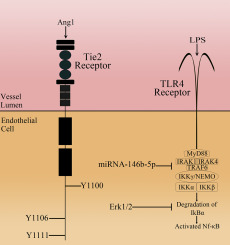Cellular Signalling ( IF 4.8 ) Pub Date : 2018-08-02 , DOI: 10.1016/j.cellsig.2018.08.001 Tracy L. Smith , Paul Van Slyke , Nina Jones , Daniel J. Dumont , C. Jane McGlade

|
The inflammatory response is essential for eradication of lipopolysaccharide (LPS) presenting microbial invaders but requires exquisite regulation to prevent detrimental vascular inflammation. Endothelial cells play active roles in both the initiation of inflammation, through the detection of LPS by Toll-like Receptor 4 (TLR4), and the resolution of inflammation, through the actions of the receptor tyrosine kinase, Tie2. The process by which Tie2 attenuates LPS-TLR4 driven inflammation is poorly understood. To investigate the effects of Tie2 on TLR4 signalling, Nf-κB activation was monitored in cells expressing Tie2 mutants harboring tyrosine (Y) to phenylalanine (F) substitutions in the cytoplasmic domain. Tie2 attenuated LPS induced Nf-κB activation in a manner requiring Tie2 kinase activation, the carboxy-terminal tyrosine residue Y1100 and downstream Erk1/2 signalling. Tyrosine 1100 was also required for the Tie2 dependent decrease in expression of the TLR4 signalling proteins, TRAF6 and IRAK1 and stabilization of the Nf-κB inhibitor, IκBα. In contrast, upregulation of known TLR4 antagonist miRNA-146b-5p required all three tyrosine phosphorylation sites in Tie2. Finally, we confirmed in an in vivo model that activation of Tie2 signalling reduces LPS mediated inflammation. Our results show that Y1100 initiated Erk1/2 signalling is essential for the anti-inflammatory effect of Tie2 on TLR4 mediated inflammation.
中文翻译:

通过Erk1 / 2的Tie2信号调节TLR4驱动的炎症
炎症反应对于消除存在微生物的脂多糖(LPS)是必不可少的,但需要进行精确调节以防止有害的血管炎症。内皮细胞在通过Toll样受体4(TLR4)检测LPS引发炎症反应和通过受体酪氨酸激酶Tie2的作用解决炎症方面均发挥着积极作用。Tie2减轻LPS-TLR4驱动的炎症的过程了解甚少。为了研究Tie2对TLR4信号的影响,在表达Tie2突变体的细胞中监测了Nf-κB活化,该突变体在胞质域中具有酪氨酸(Y)到苯丙氨酸(F)取代。Tie2以要求Tie2激酶激活的方式减弱了LPS诱导的Nf-κB激活,羧基末端的酪氨酸残基Y1100和下游的Erk1 / 2信号。TLR2信号蛋白TRAF6和IRAK1的Tie2依赖性减少以及Nf-κB抑制剂IκBα的稳定也需要酪氨酸1100。相反,已知的TLR4拮抗剂miRNA-146b-5p的上调需要Tie2中的所有三个酪氨酸磷酸化位点。最后,我们在Tie2信号激活减少LPS介导的炎症的体内模型。我们的结果表明,Y1100启动的Erk1 / 2信号传导对于Tie2对TLR4介导的炎症的抗炎作用至关重要。



























 京公网安备 11010802027423号
京公网安备 11010802027423号